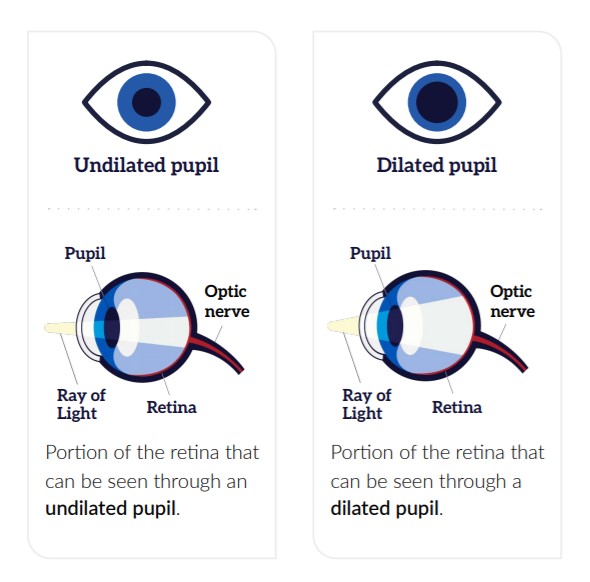
Comprehensive dilated eye exams
Having regular, comprehensive dilated eye exams can help prevent vision loss. Early detection and timely treatment of eye diseases can help save your sight. In many cases, a comprehensive dilated eye exam is the only way to detect eye diseases that can cause blindness. When was your last eye exam?
Why choose a dilated eye exam?
When a pupil is not dilated, it is difficult for a doctor to examine the back of the eye. During a comprehensive dilated eye exam the entire retina of an eye can be examined, as well as the optic nerve and macula.
A dilated eye exam may include the following tests:
Pupil dilation:
A pupil can be dilated by the use of specific eye drops. These will be administered by a specialized eye care professional and will widen the pupils after approximately 15-30 minutes. Your retina, optic nerve and macula can then be examined through a special magnifying lens. Your eye specialist will look for eye conditions like macular degeneration (usually age-related), diabetic retinopathy or damage to the optic nerve. This last damage can indicate glaucoma. Your sight and close up vision may remain blurry after the exam. It typically takes about 4-6 hours for the pupil dilation to wear off
Tonometry:
Tonometry is a test that helps detect glaucoma by measuring the pressure within the eye. Your eye care professional may direct a small puff of air onto your eye or may gently place a pressure-sensitive tip near or against your eye. He or she may also insert numbing drops in your eye to perform this test. Having elevated eye pressure may be a sign of glaucoma.
Visual Field Test:
A visual field test measures your side, or peripheral, vision. This test helps your eye care professional determine whether you have lost side vision, a sign of problems affecting the optic nerve such as glaucoma.
Visual Acuity Test:
This is a simple test to measure how well you can see the detail and shapes of letters and symbols from a specific distance. Usually, one eye is tested at the time (the other one will be covered) and your eye specialist will ask you to read out loud the smallest letters that you are able to distinguish from the chart.
Tip for Healthy Eyes
Find out about the eye health in your family. Did your parents or grandparents have any eye conditions? We get our eye color from our parents, but did you know that many eye diseases can run in families, too? Talking about this with your family members can help you determine if you have a higher risk of developing an eye condition. If you learn that eye diseases run in your family, talk to your eye doctor.





